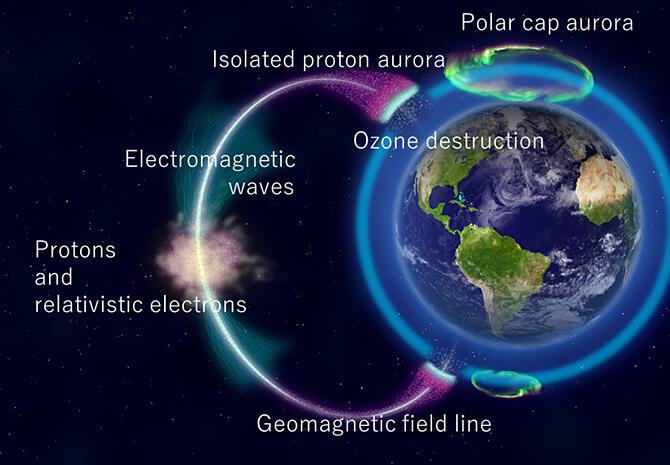An international research group led by Associate Professor Mitsunori Ozaki and Professor Satoshi Yagitani of the School of Electrical, Information and Communication Engineering, College of Science and Engineering, Kanazawa University, Professor Kazuo Shiokawa and Associate Professor Yuichi Otsuka of the Institute for Space-Earth Environmental Research, Nagoya University, Associate Professor Ryuho Kataoka of the National Institute of Polar Research, Chief Scientist Satoshi Nakahira of the Japan Aerospace Exploration Agency, NASA Langley Research Center, Johns Hopkins University Applied Physics Laboratory, and Athabasca University and the University of Alberta in Canada, has used satellite remote sensing and ground-based electromagnetic wave observations to discover extreme localized ozone depletions of less than 400 km in size in the mesosphere at an altitude of 50 to 80 km associated with a special type of aurora called an "isolated proton aurora."

Provided by Kanazawa University
The Earth's atmosphere is bombarded not only by solar radiation but also by galactic cosmic rays and high-energy plasma (ions and electrons), which ionize the atmosphere and produce nitrogen oxides (NOx) and hydrogen oxides (HOx), which are believed to contribute to changes in the ozone layer. However, scientists have not been able to quantitatively evaluate when, where, and how much the high-energy plasma affects the Earth's atmosphere. The reason is that high-energy plasma is not a directly visible phenomenon.
To shed light on the effects of atmospheric changes due to radiation belt electron precipitation, the research group investigated the effects of mesospheric ozone in the mesosphere directly below the isolated proton aurora. For the investigation, the researchers had to measure the aurora and radiation belt electrons to determine where the electromagnetic waves and radiation belt electrons precipitated, which provided clues as to when the atmospheric precipitation of radiation belt electrons began, and then made comprehensive observations in combination with ozone fluctuations directly beneath the aurora. Their observations showed that the mesospheric ozone immediately below the isolated proton aurora decreased by 10-60% in the hour and a half following the onset of the isolated proton aurora. This was a greater decrease than anticipated in the simulation study.
"We were able to pinpoint the position of the radiation belt electrons from satellite observations of the aurora, but we don't know what's happening in the region where the satellite doesn't pass," said Ozaki. "Electromagnetic waves have different attenuation and reflection at different frequencies depending on the environment in which they propagate. Moving forward, we would like to promote the development of ground-based remote sensing technology that can locate the position of radiation belt electron precipitation by observing electromagnetic waves in a wide frequency band from the ground, regardless of time of day or location, to deepen our understanding of changes in the Earth's atmospheric environment."
■ Isolated proton aurora: It is known that the plasma oscillates from electromagnetic waves produced at special frequencies below 1 Hz, and the protons and radiation belt electrons that emit the isolated proton aurora fall to the earth. Auroras usually appear in a belt around the North and South Poles at geomagnetic latitudes of around 65° to 75°, but isolated proton auroras appear as isolated spots or bands at slightly lower latitudes.
Journal Information
Publication: Scientific Reports
Title: Localized mesospheric ozone destruction corresponding to isolated proton aurora coming from Earth's radiation belt
DOI: 10.1038/s41598-022-20548-2
This article has been translated by JST with permission from The Science News Ltd. (https://sci-news.co.jp/). Unauthorized reproduction of the article and photographs is prohibited.




